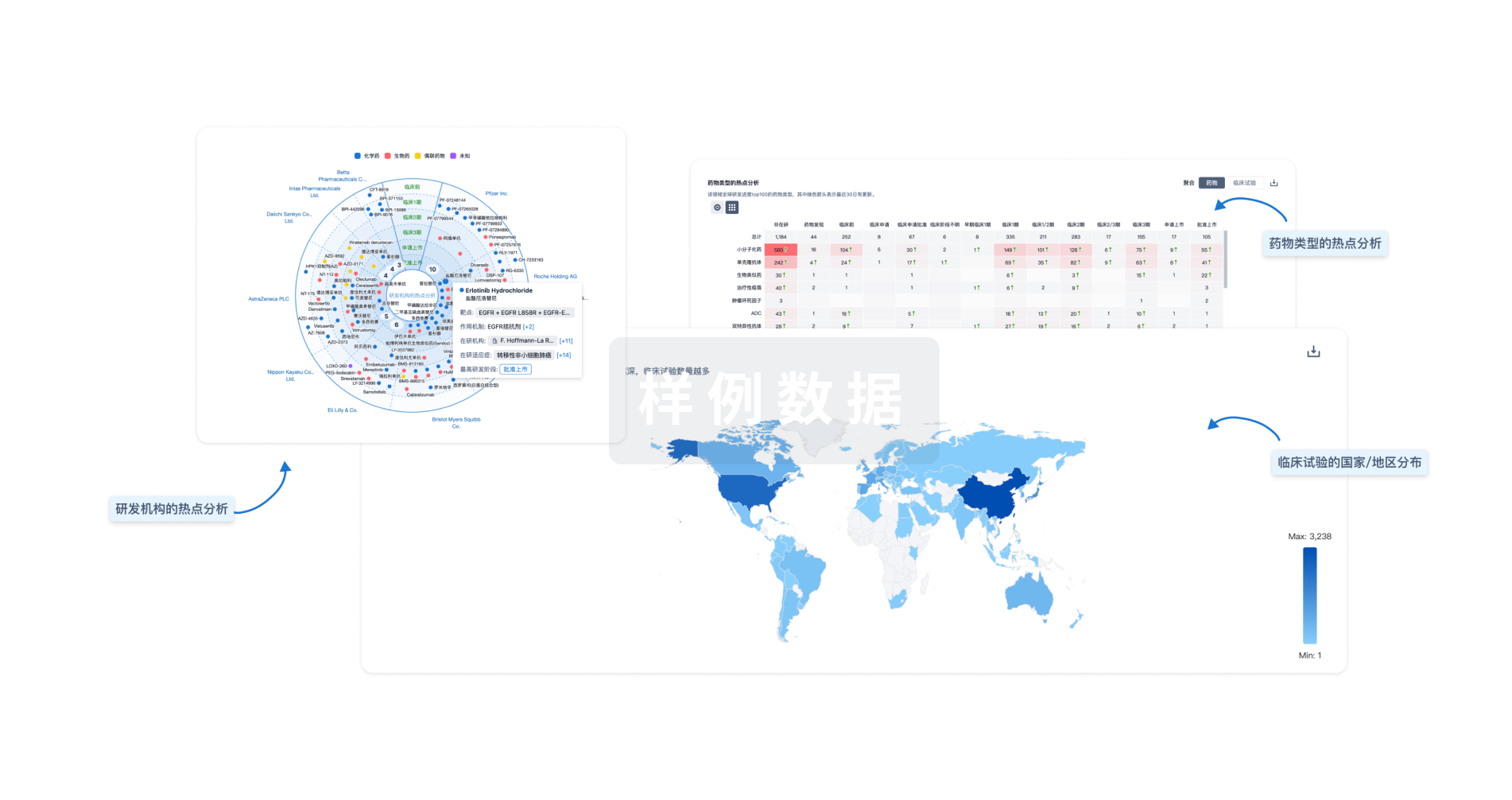预约演示
更新于:2025-05-07
Xerophthalmia
干眼症
更新于:2025-05-07
基本信息
别名 Conjunctival Xerosis、EYES DRY、Tear film insufficiency + [25] |
简介 Dryness of the eye surfaces caused by deficiency of tears or conjunctival secretions. It may be associated with vitamin A deficiency, trauma, or any condition in which the eyelids do not close completely. |
关联
145
项与 干眼症 相关的药物靶点 |
作用机制 脂质调节剂 |
原研机构 |
非在研适应症 |
最高研发阶段批准上市 |
首次获批国家/地区 美国 |
首次获批日期2023-05-18 |
靶点 |
作用机制 CaN抑制剂 |
在研机构 |
原研机构 |
在研适应症 |
非在研适应症- |
最高研发阶段批准上市 |
首次获批国家/地区 韩国 |
首次获批日期2018-11-26 |
靶点 |
作用机制 CD11a拮抗剂 |
最高研发阶段批准上市 |
首次获批国家/地区 美国 |
首次获批日期2016-07-11 |
93
项与 干眼症 相关的临床试验ChiCTR2500101174
Construction and Empirical Study of a Health Education Program for Dry Eye Syndrome Patients Based on the COM-B Model
开始日期2025-05-01 |
申办/合作机构- |
CTR20244551
环孢素眼用凝胶治疗中至重度干眼患者的有效性和安全性的多中心、随机、双盲、安慰剂对照Ⅲ期临床研究
主要目的:评估环孢素眼用凝胶对比安慰剂治疗中至重度干眼患者84天的有效性和安全性。
次要目的:评估环孢素眼用凝胶治疗中至重度干眼患者168天的安全性。
开始日期2025-03-17 |
申办/合作机构 |
NCT06771427
Systemic Proteomic Analysis of Plasma Exosomes to Explore the Immunomodulation Reflected to Sjogren's Syndrome and Dry Eye Syndrome
By analyzing the differential proteins in exosomes, this study aims to understand the pathological mechanisms of SJS and DES, identify potential diagnostic and therapeutic methods, and advance the diagnosis and treatment of these diseases.
开始日期2025-01-16 |
100 项与 干眼症 相关的临床结果
登录后查看更多信息
100 项与 干眼症 相关的转化医学
登录后查看更多信息
0 项与 干眼症 相关的专利(医药)
登录后查看更多信息
1,575
项与 干眼症 相关的文献(医药)2025-05-01·Journal of Autoimmunity
Clinical targeted treatment in Sjogren's disease: A systematic literature review for an evidence-based medicine approach
Review
作者: Genovali, Irene ; Marino, Annalisa ; Di Corcia, Letizia Pia ; Bombardieri, Michele ; Pontarini, Elena ; Giacomelli, Roberto ; Vomero, Marta ; Berardicurti, Onorina ; Currado, Damiano ; Pilato, Andrea ; Navarini, Luca
2025-04-01·Journal of Ocular Pharmacology and Therapeutics
Therapeutic Effects of Human Placental Extracts Eye Drops in Experimental Dry Eye and Alkali Burn
Article
作者: Choi, Ji Suk ; Jin, Hui ; Yoon, Kyung Chul ; Liu, Jingting ; Moon, Jayoung ; Jiang, Enying ; Qi, Hong ; Yoon, Hyeon-Jeong ; Yoon, Hee Su
2025-04-01·BMJ Case Reports
Rare co-occurrence of severe vitamin A deficiency in an early adolescent girl with Bartter syndrome
Article
作者: Tahir, Muhammad Sikandar ; Abbas, Mehdi ; Huggard, Dean ; Riazat, Muhammad Imran
804
项与 干眼症 相关的新闻(医药)2025-05-04
·梅斯医学
29岁的林女士,这一年多来总是双眼反复发红、刺痛、畏光,几乎每个月都要跑一次眼科门诊。她被诊断为“虹膜睫状体炎”,点了无数眼药水,症状稍缓后又反复。“是不是干眼症太严重?”、“是不是过敏?”、“是不是老熬夜?”她问过许多医生,也试过各种护眼方式,但病情始终反复。直到这一次来院复查,眼科医生发现她眼部异常并不仅仅是炎症那么简单。双眼表层巩膜呈散在结节状充血,后部角膜缘竟出现了新生血管和“影子血管”,更关键的是:她还提到了“最近常常头晕”!“有没有听力下降?耳鸣?耳闷?”医生一问,林女士一愣:“确实有点耳闷,没太在意。”种种线索拼在一起,医生高度怀疑:这不是单纯的眼病,而是罕见的Cogan综合征!累及眼、听觉-前庭系统的综合征1945年Cogan首次详细描述一种听觉-前庭障碍伴发非梅毒性基质性角膜炎的独立临床病例,将其命名为Cogan综合征。该病是一种累及眼、听觉-前庭系统的综合征,属于自身免疫性疾病,主要表现为非梅毒性角膜基质炎、前庭功能障碍、听力下降以及全身症状。该病临床上较罕见,好发于青壮年,无年龄差异,文献报道白种人居多。角膜基质炎大多数患者都会出现眼红、畏光及眼痛等,很少无症状。该病患者大多数都是双眼相继或同时发病,症状随病程进展逐日加重。分型Cogan综合征分为典型与非典型两种类型。典型Cogan综合征表现为非梅毒性角膜炎和美尼尔听觉-前庭障碍。诊断典型的综合征主要依据非梅毒性角膜基质炎、急性发作的感音神经性听力损失、类似美尼尔病的前庭症状及发病两年内听力进行性损失致聋。眼部症状除了基质性角膜炎外,还可有结膜炎、虹膜炎和睑板腺囊肿等。非典型的Cogan综合征眼部损伤多表现为不伴基质性角膜炎的其他病变。另一种非典型的Cogan综合征眼部表现具有典型的基质性角膜炎症状,但耳部症状为非美尼尔听觉-前庭障碍,或者眼耳症状不同时发生(一般2年内先后发生)。至今该病仍然没有确切的诊断标准,但是可以根据患者的症状体征及鉴别诊断对其进行确诊。临床表现该病首发症状可以是眼部炎症性反应,也可以是眼部症状伴发内耳症状。1.内耳症状:表现为骤然出现的类似美尼尔病样发作:眩晕,恶心,呕吐,共济失调,耳鸣,突发性感音神经性聋。内耳症状可与眼部症状同时出现,也可以晚于眼部症状数周或2年内先后出现。2.眼部表现:可出现较多变异,但最典型的眼部症状是非梅毒性间质性角膜炎,表现为眼红、畏光、眼睛不适、疼痛和视物模糊。在裂隙灯下可见斑片状颗粒状角膜浸润,反复发作患者可出现云状角膜变性。3.耳部损害:听力进行性下降为最主要的耳部损害,发病2年内,有54%典型的和37%非典型的Cogan综合征患者会发生单耳或双耳的耳聋。经过抗炎与全身激素治疗,听力较视力下降的改善较差。4.全身其他系统:引起其他系统症状。如,呼吸系统的上呼吸道感染,可见胸痛、呼吸困难等;心血管系统可见主动脉炎、心包炎或者心律失常、高血压等;消化系统可见腹部疼痛不适、消化不良、腹泻、便血、肝脾肿大等;以及皮肤可见红斑、风疹,也可出现多发性关节炎或关节痛。治疗糖皮质激素是治疗CS的基本药物,宜早期大量应用,起效后逐渐减量维持。糖皮质激素无效时可联用免疫抑制剂。结膜炎、巩膜炎、角膜炎、前葡萄膜炎局部应用糖皮质激素有效。无效时可用环孢霉素A滴眼液,严重眼部炎症需服用泼尼松。参考资料1. 范梓晰,靳荷,黄里佳,等. Cogan综合征二例. 中国实用眼科杂志,2015,33(02):200-201.2. 李雪静,陈楠.老年Cogan综合征1例[J].中国现代医学杂志,2019,29(09):126.3.毛秋月,杨涛,彭安全,等.Cogan综合征诊治的研究进展[J].中华耳科学杂志,2023,21(01):115-120.来源 | 梅斯医学编辑 | wanny神经系统罕见病交流群↓点击下方“阅读原文”,下载梅斯医学APP吧!
蛋白降解靶向嵌合体
2025-05-04
·药明康德
编者按:过去的2024年,在美国FDA批准的所有小分子新药中,药明康德支持了其中6款的生产,占19%;自2018年以来,美国FDA所批准的所有小分子新药中,18%由药明康德赋能,这意味着几乎每5个美国FDA批准的小分子新药中,就有1个得到了药明康德的支持。作为创新赋能者、客户信赖的合作伙伴以及全球医药及生命科学行业的贡献者,药明康德将持续通过独特的“CRDMO”业务模式,助力更多合作伙伴,为全球病患带来突破性创新疗法。根据PDUFA的目标日期,预计2025年5月,美国FDA将对3款创新药物的批准做出监管决定。本文将对这些疗法进行相关介绍。▲5月美国FDA可能批准的新药(点击可见大图)活性成分:Pegzilarginase适应症:精氨酸酶缺乏症(ARG1-D)公司名称:Immedica PharmaPegzilarginase是一种重组人体精氨酸酶,可促进体内精氨酸代谢。这种酶替代疗法可快速、持续地降低血浆中精氨酸及其毒性代谢物的水平,同时改善临床症状。Pegzilarginase已在欧盟和英国获得批准,用于治疗成人、青少年和2岁及以上儿童的精氨酸酶缺乏症。根据2024年2月发表在eClinicalMedicine杂志上的3期临床研究结果,共有32名患者入组该研究并接受随机分组,其中21名患者接受了pegzilarginase治疗,11名患者接受了安慰剂治疗。研究结果显示,在第24周时,接受pegzilarginase治疗的患者血浆精氨酸(pArg)的几何平均值从354.0 μmol/L显著降低至86.4 μmol/L,而安慰剂组患者的pArg水平仅从464.7 μmol/L降至426.6 μmol/L(95% CI:-67.1%至-83.5%;p<0.0001)。此外,pegzilarginase治疗使90.5%的患者pArg水平恢复正常,而安慰剂组中这一比例为0%。在功能性活动能力方面,pegzilarginase治疗也显示出显著的临床改善效果。这些疗效在随后的24周持续治疗中得以长期维持。在安全性方面,pegzilarginase耐受性良好,不良事件大多为一过性且严重程度为轻度或中度。活性成分:Telisotuzumab vedotin(Teliso-V)适应症:非小细胞肺癌(NSCLC)公司名称:艾伯维Teliso-V是一款靶向c-Met的抗体偶联药物(ADC),以微管蛋白抑制剂MMAE作为毒性有效载荷。该疗法在2022年1月获FDA突破性疗法认定,治疗非小细胞肺癌。艾伯维于2024年10月为teliso-V提交了一份生物制品许可申请(BLA),以寻求加速批准该疗法用于治疗c-Met蛋白过度表达的经治局部晚期或转移性非鳞状NSCLC成人患者,这些患者肿瘤的表皮生长因子受体(EGFR)为野生型。该BLA得到了LUMINOSITY临床2期试验数据的支持,该试验旨在评估teliso-V在c-Met过表达NSCLC患者中的安全性和有效性。之前公布的独立中心审评(ICR)分析结果显示,肿瘤c-Met高度表达和中度表达患者的总缓解率分别为35%和23%。此外,其他终点显示了有意义的临床结局,包括c-Met高度表达和中度表达患者的中位缓解持续时间分别为9个月和7.2个月,中位总生存期分别为14.6个月和14.2个月。Teliso-V的安全性特征与既往结果一致,未发现新的安全性问题。Teliso-V单药治疗的不良事件通常为可控且耐受良好。活性成分:Acoltremon(AR-15512)适应症:干眼症公司名称:AlconAR-15512是一款局部TRPM8激动剂,是治疗干眼症体征和症状的潜在“first-in-class"候选产品。AR-15512在两项关键性3期临床试验COMET-2和COMET-3中均取得了积极结果,这两项试验旨在评估该疗法的疗效和安全性。分析显示,在上述两项研究中,AR-15512均达到主要终点。在这两项研究中,共有超过930例干眼症受试者入组,并以1:1的比例随机分配至AR-15512组或溶剂对照组。试验的主要终点为在第14天时,未麻醉Schirmer评分(泪液生成指标)至少增加10 mm的受试者比例达到统计学显著性(p<0.0001)。这些数据与AR-15512的已知作用机制一致。此外,次要终点的数据表明,与对照组相比,AR-15512可快速起效并持续促进泪液产生,最早在第1天出现,并持续至第90天。总体而言,AR-15512耐受性良好,且未报告任何严重眼部不良事件。参考资料:[1] BLA for pegzilarginase in the treatment of arginase 1 deficiency (ARG1-D) accepted for priority review by the U.S. FDA. Retrieved April 15, 2025 from https://www.immedica.com/en/press/bla-pegzilarginase-treatment-arginase-1-deficiency-arg1-d-accepted-priority-review-us-fda[2] Russo, Rossana Sanchez et al. “Efficacy and safety of pegzilarginase in arginase 1 deficiency (PEACE): a phase 3, randomized, double-blind, placebo-controlled, multi-centre trial.” EClinicalMedicine vol. 68 102405. 12 Jan. 2024, doi:10.1016/j.eclinm.2023.102405[3] AbbVie Submits Biologics License Application to the FDA for Telisotuzumab Vedotin (Teliso-V) in Previously Treated Non-Small Cell Lung Cancer. Retrieved April 15, 2025 fromhttps://www.prnewswire.com/news-releases/abbvie-submits-biologics-license-application-to-the-fda-for-telisotuzumab-vedotin-teliso-v-in-previously-treated-non-small-cell-lung-cancer-302261263.html[4] Alcon Announces Positive Topline Results From Phase 3 COMET Trials of AR-15512, a Novel Topical Drug Candidate for Dry Eye. Retrieved April 15, 2025 from https://www.alcon.com/media-release/alcon-announces-positive-topline-results-phase-3-comet-trials-ar-15512-novel-topical免责声明:本文仅作信息交流之目的,文中观点不代表药明康德立场,亦不代表药明康德支持或反对文中观点。本文也不是治疗方案推荐。如需获得治疗方案指导,请前往正规医院就诊。版权说明:欢迎个人转发至朋友圈,谢绝媒体或机构未经授权以任何形式转载至其他平台。转载授权请在「药明康德」微信公众号回复“转载”,获取转载须知。分享,点赞,在看,聚焦全球生物医药健康创新
突破性疗法临床3期临床结果加速审批临床2期
2025-05-01
·药事纵横
声明:因水平有限,错误不可避免,或有些信息非最及时,欢迎留言指出。本文仅作医疗健康相关药物介绍,非治疗方案推荐(若涉及);本文不构成任何投资建议。据不完全统计,2025年1-4月FDA共拒批了6款药物,“双艾疗法”和干眼症药物Reproxalap已不是首次在FDA碰壁。究其原因,其中有两款药物因CMC问题被拒批,两款药物因临床数据问题被拒批,一款药物因第三方问题被拒批。小编总结如下:Atara:Ebvallo2025年1月16日,Atara Biotherapeutics宣布美国FDA拒绝批准其细胞疗法Ebvallo(Tabelecleucel)的生物制品许可申请 (BLA)。该申请作为单一疗法治疗2岁及以上患有Epstein-Barr病毒阳性(EBV+)移植后淋巴细胞增殖性疾病(PTLD) 的成人和儿童患者,这些患者之前至少接受过一种疗法,包括含抗CD20的方案。根据新闻稿,本次未获得FDA批准仅与第三方生产商的检查结果有关。CRL中没有提及BLA中的生产工艺、临床疗效或临床安全性数据相关的缺陷,FDA也没有要求进行任何新的临床研究来支持Ebvallo的获批。Tab-cel是一种同种异体、“现货型” EBV特异性T细胞免疫疗法,可靶向并消除EBV 感染的细胞,除了用于治疗EBV阳性的移植后淋巴增殖性疾病,目前处在针对其他 EBV 相关的血液恶性肿瘤和实体瘤的早期开发阶段 。受此影响,Atara 股价暴跌40%。尽管如此,Atara还是寻求与FDA、Pierre Fabre实验室和第三方制造商合作,以实现Ebvallo在美国的获批。Atara的首席执行官Cokey Nguyen博士表示,对Ebvallo最终获批充满信心,重新申请后可能在六个月内获批。欧盟已于2022年12月授予EBVALLO上市许可。恒瑞医药:“双艾”疗法2025年3月21日,恒瑞医药公告称:收到FDA关于卡瑞利珠单抗联合甲磺酸阿帕替尼用于不可切除或转移性肝细胞癌患者一线治疗的生物制品许可申请的完整回复信。回复信中,FDA表示相关生产场地检查需进一步提交答复,但FDA并未在回复信中说明具体原因。韩国HLB公司方面说法指出,此次FDA拒批的原因仍与卡瑞利珠单抗的生产和质量控制(CMC)问题有关。而“双艾”组合第一次遭拒的原因也涉及CMC问题。2024年5月,恒瑞医药第一次收到该上市申请的完整回复信,FDA在回复信中表示,由于生产场地检查缺陷和部分国家的旅行限制,导致无法全部完成该项目必需的生物学研究监测计划(BIMO)临床检查,该申请无法在规定审查时间内得到批准。同年10月,恒瑞医药表示已重新向FDA提交注射用卡瑞利珠单抗联合甲磺酸阿帕替尼片肝癌一线治疗适应证上市申请并获受理。恒瑞医药表示,相关生产场地在2025年1月再次接受FDA检查,FDA核实去年发出CRL的检查中发现的问题都已经整改完毕,仅提出了3个新的改进要求,公司在规定时间内已对相关问题进行了积极回复,并一直与FDA保持密切沟通。公司将在确认具体原因后尽快采取措施并重新提交申请,以期能够获得批准。Milestone:Etripamil鼻喷雾剂3月28日,FDA 拒绝批准Milestone Pharmaceuticals的Cardamyst (etripamil) 鼻喷雾剂用于治疗阵发性室上性心动过速 (PSVT),导致该公司股价在消息发布后下跌逾 60%。Milestone 指出,CRL主要集中在CMC问题,不涉及临床研究。在CRL中FDA要求:NDA递交后根据新指南递交亚硝胺杂质补充信息;针对NDA审评期间更换的设备开展现场检查以确保其遵循cGMP。Milestone制药称对CRL表示失望,其团队将评估反馈并计划与FDA召开A类会议以讨论CRL事项。Etripamil Nasal Spray(商品名CARDAMYST™)是Milestone Pharmaceuticals开发的一种新型钙通道阻滞剂鼻喷雾剂,用于治疗阵发性室上性心动过速(PSVT)。Aldeyra:Reproxalap4月3日,美国FDA再次驳回了Aldeyra Therapeutics在研干眼症药物Reproxalap的新药上市申请 (NDA)。Aldeyra计划在未来几周内与FDA 会面,讨论本次CRL的具体内容和后续要求。FDA明确指出,需要更多临床数据来支持该药物的有效性,要求Aldeyra至少再完成一项充分且良好对照的临床试验 ,以确保reproxalap在改善干眼症相关眼部症状方面的疗效。FDA明确的关注有包括治疗臂间基线评分差异在内的方法学相关问题对结果解释等。Reproxalap为一款活性醛化物质(RASP)抑制剂,活性醛化物质含量会在眼部或系统性发炎时上升,造成眼睛发炎、泪水分泌降低、眼睛发红以及改变泪水内脂质组成,许多干眼症患者具有较高的活性醛化物质含量。2023年11月,FDA曾对Reproxalap干眼症NDA发出的CRL,指出Reproxalap未能证明治疗干眼症的有效性,同样要求至少需要额外开展一个控制良好和充分的试验证明有效性。再生元:EYLEA HD2025年4月18日,FDA已向再生元发出了完全回复信函(CRL),拒绝了其将EYLEA HD®(阿柏西普8mg注射液)的给药间隔从最长16周延长至24周的sBLA。FDA不同意再生元关于增加额外延长给药间隔的提议,但并未提供进一步的解释。再生元表示,监管机构并未指出任何安全性或有效性问题。Regeneron正在评估FDA的决定,并将在适当的时候确定未来的行动方案。EYLEA HD被批准用于湿性年龄相关性黄斑变性(wAMD)和糖尿病性黄斑水肿(DME)患者的给药间隔为每8至16周,以及糖尿病视网膜病变(DR)患者的给药间隔为每8至12周,此前需连续3个月每月给药一次。在FDA拒绝延长给药间隔的前一天,FDA已接受了再生元关于批准Eylea HD用于治疗视网膜静脉阻塞(RVO)后黄斑水肿以及将Eylea HD在所有已批准适应症中的给药频率扩大至每四周一次的补充生物制品许可申请(sBLA)并授予优先审评资格。目前的最低给药间隔在加载期后为每八周一次, FDA的目标审批日期是2025年8月19日。Telix:Pixclara4月28日,美国FDA向Telix Pharmaceuticals发出了一封完整回应函,针对其神经胶质瘤成像剂TLX-101-CDx(18F-floretyrosine或18F-FET,Pixclara)的 NDA,指出需要额外的确认性临床证据。Telix表示有几种方法可以解决 CRL 问题,包括重新分析现有(未公开)数据,或开展额外的临床试验。Pixclara是一种PET试剂,用于表征成人和儿童患者治疗相关变化引起的进展性或复发性神经胶质瘤。FET PET已被纳入神经胶质瘤成像的国际临床实践指南中,但目前美国还没有FDA批准的用于成人和儿童脑癌成像的靶向氨基酸PET试剂,鉴于Pixclara有可能解决严重未满足的医疗需求,它已被FDA指定为孤儿药并授予快速通道指定。参考资料:各公司公告
免疫疗法细胞疗法
分析
对领域进行一次全面的分析。
登录
或

Eureka LS:
全新生物医药AI Agent 覆盖科研全链路,让突破性发现快人一步
立即开始免费试用!
智慧芽新药情报库是智慧芽专为生命科学人士构建的基于AI的创新药情报平台,助您全方位提升您的研发与决策效率。
立即开始数据试用!
智慧芽新药库数据也通过智慧芽数据服务平台,以API或者数据包形式对外开放,助您更加充分利用智慧芽新药情报信息。
生物序列数据库
生物药研发创新
免费使用
化学结构数据库
小分子化药研发创新
免费使用




